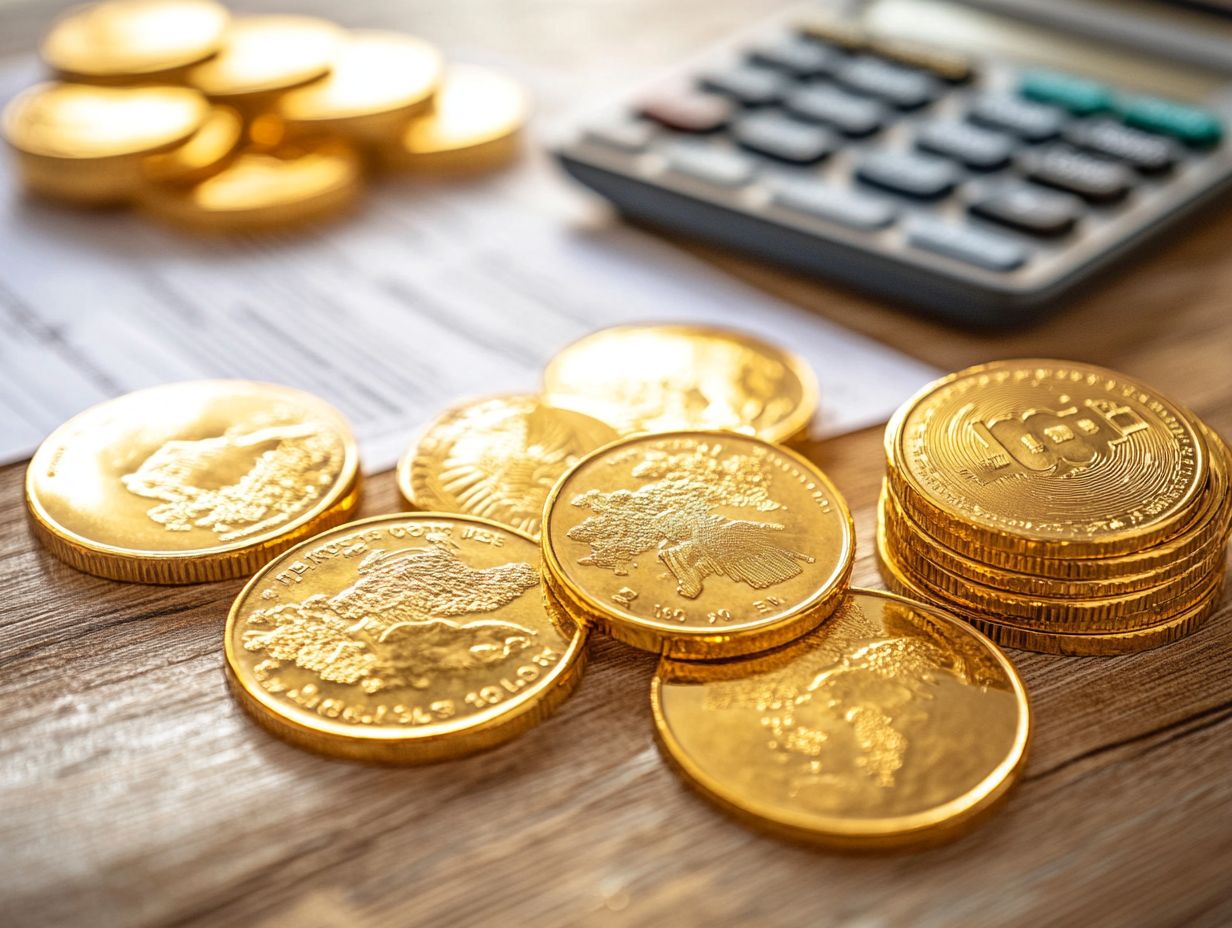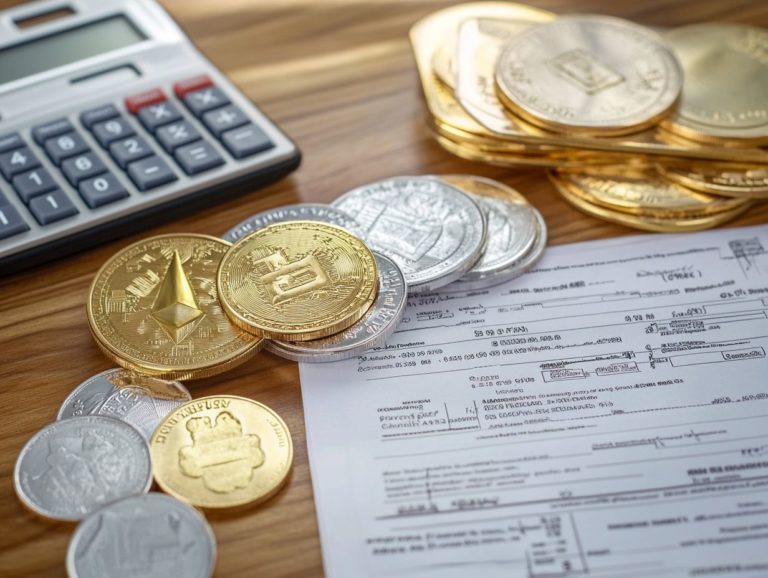Tax-Free Gold Investments: What Are Your Options?
Investing in tax-free gold is a great way to grow your wealth. It also helps reduce your tax obligations.
There are several options to consider, such as physical gold, gold ETFs, and gold mining stocks. Each option allows you to diversify your portfolio while enjoying tax advantages.
However, it s crucial to weigh potential risks like market volatility and storage costs. Whether you re a seasoned investor or just starting, this guide will help you navigate your tax-free gold investment journey with confidence.
Contents
Key Takeaways:

Tax-free gold investments offer benefits like tax breaks and diversification.
Options include physical gold, ETFs, and mining stocks.
Be sure to weigh market risks and storage costs before jumping in!
Understanding Tax-Free Investments
Tax-free investments provide a strategic path to maximize your returns while minimizing the tax implications from selling investments. By leveraging tax rules, you can navigate the complexities of regulations on various financial securities, ensuring your wealth is preserved for future generations.
This insight is particularly vital when considering investment vehicles like individual retirement accounts (IRAs), which allow for tax-free growth. As you explore options in the gold market, understanding the advantages of tax-free investments is key to crafting a robust investment strategy aligned with your long-term financial goals.
Explore Your Tax-Free Gold Options
Investing in tax-free gold opportunities offers a unique chance to diversify your portfolio while tapping into the timeless value of precious metals. Options like physical gold, gold bullion, and gold coins act as a safeguard against market fluctuations and represent tangible assets that can appreciate over time.
If you want to maximize your returns, consider gold mining stocks and gold exchange-traded funds (ETFs). These provide alternative avenues to benefit from price fluctuations and increasing demand for gold.
Physical Gold
Physical gold whether coins, bullion bars, or exquisite jewelry remains a popular choice among investors due to its intrinsic value and historical significance as a safe haven. This asset can shield you against economic uncertainties and inflation.
As you contemplate adding physical gold to your investment strategy, remember to consider factors like storage fees and liquidity. This unique asset can serve as a reliable hedge against the unpredictable stock market, offering a solid alternative during financial downturns.
While physical gold promises stability, it comes with challenges like the need for secure storage and the potential difficulty of converting gold back into cash when liquidity is urgent.
For discerning investors, understanding gold purity levels is essential. Higher purity typically equates to higher value, which can significantly influence your investment choices. Incorporating gold into a diversified portfolio can help mitigate risks associated with market volatility, allowing you to navigate the investment landscape confidently.
Gold ETFs
Gold exchange-traded funds (ETFs) let you invest in the gold market without owning physical gold. They provide an easy and liquid way to trade, appealing to both seasoned and new investors.
With benefits like lower insurance costs and no storage fees, gold ETFs are an efficient way to integrate gold into your diversified investment portfolio.
This innovative approach allows you to buy and sell shares through stock exchanges, similar to traditional equities. You can capitalize on fluctuations in gold prices without dealing with the complexities of physically managing the asset.
Gold ETFs also provide a hedge against inflation and market volatility. They often complement asset classes like equities or bonds, helping stabilize your portfolio and keeping your investment goals attainable even in uncertain economic conditions.
Gold Mining Stocks
Looking to dive into the gold market? Investing in gold mining stocks could be your golden ticket to exciting opportunities!
Unlike direct investments in gold, gold mining stocks can offer higher returns, influenced by the operational efficiencies of leading companies like Barrick Gold Corp., Newmont Corp., and Franco-Nevada Corp.
However, it s important to keep an eye on risks like market volatility and fluctuations in gold prices. The stock performance of these mining companies often correlates closely with global market conditions and geopolitical factors.
For instance, rising inflation or economic uncertainty tends to boost demand for gold, driving up mining stock values. Conversely, a strong dollar can pressure gold prices, negatively impacting stock performance.
To make informed choices, analyze key metrics like production costs and reserve levels. This will help you assess a company’s resilience in different market conditions.
Benefits of Tax-Free Gold Investments
The advantages of tax-free gold investments extend beyond simple asset allocation. They offer substantial tax benefits, improved returns, and a powerful way to diversify your portfolio.
By considering capital gains tax implications and strategic options like physical gold and gold ETFs, you can enhance your financial outcomes while ensuring a balanced asset mix.
Gold has a strong history as a reliable hedge against inflation. This makes it vital for any investment strategy focused on long-term growth and stability.
Tax Benefits
As an investor in tax-free gold investments, enjoy a range of tax benefits. These include potential exemptions on capital gains and favorable treatment for long-term capital gains, as outlined by the IRS.
By navigating the tax implications of your gold investments, you can maximize your returns while minimizing tax liabilities. Leveraging options like IRAs can facilitate tax-free growth.
Understanding these tax advantages empowers you to craft a successful investment strategy that aligns with your financial goals and follows regulatory guidelines.
Distinguishing between short-term and long-term capital gains can help you make informed decisions about your gold holdings. Short-term gains are taxed at ordinary income rates and can significantly affect your profitability.
On the other hand, long-term capital gains benefit from reduced tax rates. This makes them particularly advantageous if you focus on gold as a long-term investment.
Familiarity with these distinctions, along with compliance with IRS regulations, is essential for optimizing the tax effectiveness of your gold investments.
Start exploring your options today!
Diversification of Portfolio
Adding gold to your portfolio is a smart move for reducing risk and navigating the unpredictable waters of market volatility. The gold market often moves differently than other asset classes, allowing you to buffer your portfolio against downturns while potentially enhancing overall returns.
By understanding the unique attributes of gold, especially its reputation as a safe haven asset, you can create an investment strategy that prioritizes both stability and growth.
During times of high inflation or geopolitical uncertainty, gold tends to hold its ground, serving as a reliable hedge that can stabilize your investments. As market trends become more unpredictable, weaving this precious metal into your financial strategy can offer you significant peace of mind.
By allocating a portion of your assets to gold, you not only safeguard your wealth but also position yourself to capitalize on potential price surges when equities stumble. This foresight makes your portfolio stronger, striking a balanced approach between risk and reward.
Risks and Considerations
While tax-free gold investments offer enticing benefits, they come with their own set of risks and considerations that you must evaluate thoughtfully.
Market volatility can result in significant price fluctuations, affecting the overall value of your gold assets and the returns they yield. The costs tied to storage and insurance can chip away at your profits, making it crucial for you to incorporate these factors into your broader investment strategy when contemplating whether to add gold to your portfolio.
Market Volatility

Market volatility plays a crucial role in shaping gold prices. Keep a keen eye on price fluctuations as part of your investment strategy. Factors such as geopolitical tensions, economic indicators, and currency value changes can prompt rapid movements in the gold market. Understanding these dynamics is essential to take advantage of gold’s unique qualities as a safe haven asset during uncertain times.
Shifts in interest rates and inflation expectations also add to the unpredictability of gold prices. You may notice that when the economic outlook becomes shaky, demand for gold can surge, driving prices upward.
To navigate this volatility effectively, consider strategies like diversification and using stop-loss orders to mitigate risks associated with sudden price swings. By watching market trends closely and staying adaptable, you’ll be better positioned to respond effectively and potentially secure your investments against fluctuating gold prices.
Storage and Insurance Costs
Investing in physical gold? Pay close attention to storage and insurance costs they can make or break your returns!
When thinking about safe storage options whether in specialized vaults or secure home safes you’ll find that these usually come with substantial fees that can chip away at your profits over time.
Insurance costs to protect your gold from theft or damage add to your expenses. The choice of where to store your gold plays a critical role in your liquidity. For example, while private vaults might offer superior security, they can involve lengthy withdrawal processes and escalating costs that make accessing your funds cumbersome.
Storing gold at home may seem attractive due to immediate access, but it opens you up to risks such as burglary, highlighting the necessity of robust insurance.
By grasping these dynamics, you can make informed choices that effectively balance security and convenience, leading to enhanced returns over time.
Start exploring your gold investment options today!
How to Get Started with Tax-Free Gold Investments
Embarking on tax-free gold investments requires a thoughtful approach. This approach enables you to make informed decisions about your financial future.
Start by defining clear investment goals; this sets the foundation for your strategy.
Next, consider the various ways to invest at your disposal, whether it s gold ETFs or physical gold. Understanding these options is crucial for successfully navigating the intricacies of the gold market.
Establish a brokerage account designed for gold investments. This will simplify the process, allowing you to manage your assets and execute transactions with ease and efficiency.
Steps to Take
Your first step is to define a clear investment strategy. This means assessing your risk tolerance, determining your investment horizon, and outlining your financial goals.
Selecting the right investment option be it physical gold, gold ETFs, or gold mining stocks will ensure your strategy aligns with your objectives.
Establishing a brokerage account tailored for gold investments will facilitate smooth transactions, positioning you for success in the gold market.
Understanding the importance of these factors can enable informed decisions. Start by evaluating your risk tolerance; it dictates your choices and helps you stay calm during market fluctuations.
Clear financial goals act as your roadmap, illustrating how much you should invest and when to liquidate assets for optimal returns.
Once you have these foundational elements in place, dive into researching various investment options that align with your defined risk levels and goals.
Setting up a brokerage account specifically for gold investments will streamline the buying and selling process, which is crucial in your pursuit of capital growth.
Expert Tips and Advice
Expert tips can significantly enhance your understanding of the gold market. Staying updated on market trends, fluctuations in gold prices, and insights from industry leaders gives you a competitive edge.
Consider diversifying your investment options by blending physical gold with gold ETFs or mutual funds. This optimizes your returns while managing risk effectively.
To navigate the complexities of gold investing, use valuable resources such as market analysis reports and webinars hosted by experts. These insights illuminate the factors affecting supply and demand, including geopolitical events and economic indicators.
Regularly assessing your investment portfolio is crucial. This practice helps you recognize performance patterns and adapt to changes in the market landscape.
By employing these strategies, you can develop a deeper appreciation for the gold market, ultimately leading to more strategic and profitable investment decisions.
Frequently Asked Questions

What is a tax-free gold investment?
A tax-free gold investment lets you buy and hold physical gold without paying taxes on profits.
What are my options for tax-free gold investments?
There are several options for tax-free gold investments, including gold individual retirement accounts (IRAs), gold exchange-traded funds (ETFs), and gold sovereign coins. Each option has its advantages and considerations, so research and consult with a financial advisor before making a decision.
How do gold IRAs work?
Gold IRAs function similarly to traditional IRAs, but instead of holding stocks, bonds, or mutual funds, they hold physical gold or other precious metals. These investments are held in a custodian account and are subject to specific IRS regulations and contribution limits.
What is a gold ETF?
A gold ETF is a type of investment fund that holds physical gold as its underlying asset. These funds can be bought and sold on stock exchanges, making them more liquid for investing in gold. However, unlike physical gold, gold ETFs are subject to capital gains taxes.
Risks of Tax-Free Gold Investments
Like any investment, tax-free gold investments come with risks. These include fluctuations in the gold market, fees for keeping your gold safe, and the potential for fraud.
Make sure to weigh these risks carefully before you invest!
Converting Existing Gold Investments
It is possible to convert certain gold investments into a tax-free option. For example, you can roll over a traditional IRA into a gold IRA.
There may also be tax implications when converting your investments. Consult a financial advisor to understand your options.
If you have more questions or need guidance, feel free to reach out for more information!














